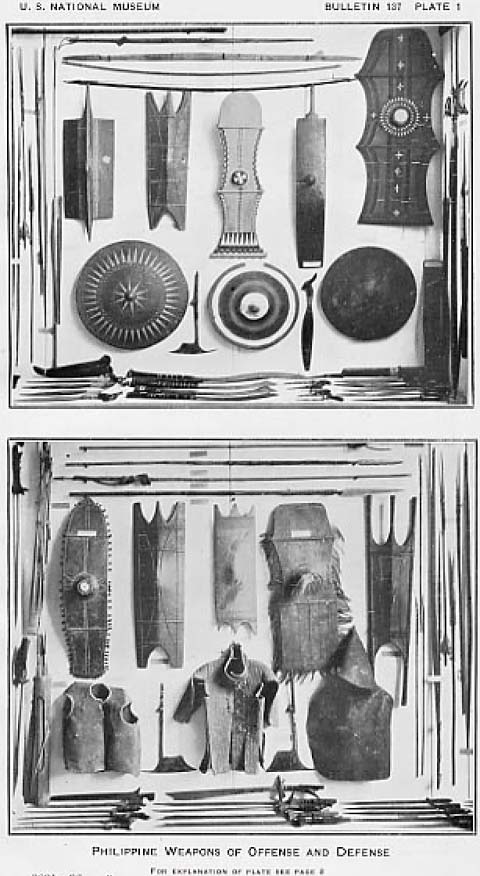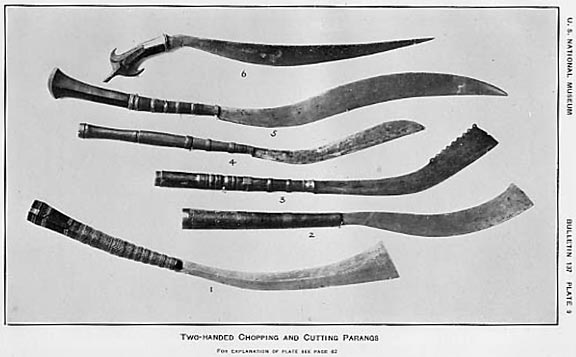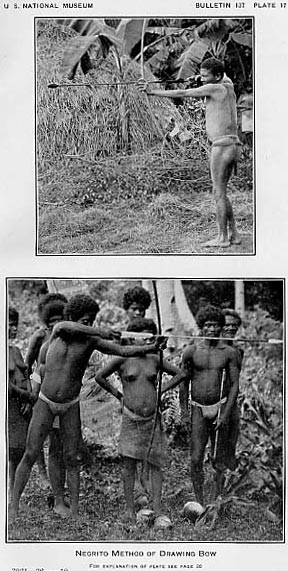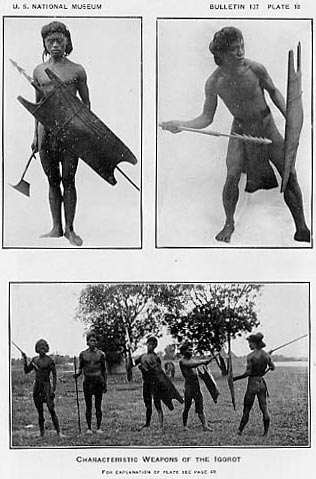Plates from:
Herbert W. Krieger's
The Collection of Primitive Weapons and Armor of the Philippine
Islands
in the United States National Museum
Smithsonian Institution;
United States National Museum, Bulletin 137 (1926)

Plate 1.
Philippine weapons of offense and defense. Spears, lances, and
halberds. Bows, arrows, and arrow cases. Blowguns, darts, and
dart cases. Clubbed weapons and shields. Hand weapons for piercing
and stabbing. Bolos. Cutting and slashing blades. Swords for
cutting and chopping. Beheading swords. Head axes. Straight and
wavy krisses. Circular shields for parrying and targets. Oblong,
pronged, clubbed, and tufted shields of hollowed wood. Body.
armor of horn, hide, cordage, and fiber construction.

Plate 2.
Projectile weapons: Blowguns, bows, arrows and darts, quiver
and dart case. No. 1. Palmwood bow; highly polished, grooved,
concavo-convex self-bow. Negritos, Zambales Mountains, Island
of Luzon. 2. Heavy palmwood self-bow; flat surfaces, slightly
concave on inner side. Negritos, Negros, Visayan Island, P.I.
3. Palmwood bow wrapped with rattan. Bagobo, Mindanao. 4. Palmwood
bow; cord of bamboo splint. Moro, Mindanao. 5. Bamboo blowgun:
Surface decorated with burned spiral bands and rings; lining
tube of reed, sight elevation. Batak, Island of Palawan, Philippine
Archipelago. 6. Arrow case of bamboo provided with rattan basketry
cap. Moro, western Mindanao. 7.Blowgun darts and dart case. Batak,
Palawan Island.

Plate 3.
Simple and compound arrowheads of palmwood and bamboo. No. 1.
Palmwood arrowhead and bamboo shaft. Moro, Mindanao. 2. Reed
arrow with palmwood foreshaft. Moro, Mindanao. 3. Bamboo arrow
with palmwood foreshaft; poisoned bamboo arrow point inserted
in foreshaft. Bikol, Luzon. 4. Large arrow of bamboo with arrowhead
of split bamboo, Bagobo, Mindanao. 5. Triagular shape arrowhead
of bamboo, harpoon shaft. Negritos, Zambales Mouutains, Luzon.
6. Barbed, triangular bamboo arrowhead, harpoon shaft. Negritos,
Zambales Mountains, Luzon Island. 7. Fish arrow with compound
head of bamboo. Bagobo, Mindanao. 8. Three-pronged or trident
compound arrow. Negritos. Zambales Mountains, Luzon.

Plate 4.
Metallic harpoon and arrowheads provided with barbed, hastate,
three-pointed, harpoon, and composite points. Shaftments. No.
1. Short, flat, lanceolate arrowhead,designed to make a large
wound and to cause profuse bleeding. Negritos Zambales Mountains.
2. Long, triangular, iron arrow point, palmwood foreshaft, unfeathered
cane shaft. Moro, western Mindanao. 3. Small, lanceolate shape
iron arrowhead, long bamboo shaft; heavy palmwood foreshaft,
bulbous at the base. Old Bikol arrow type. 4. Leaf-shape arrow
point of sheet copper, bamboo shaft, foreshaft of wood fast set
in shaft with resin. Moro. 5. Feathered bamboo shaft, large lanceolate
shape arrow point. Negritos, Luzon. 6. Leaf-shape iron arrowhead
of excellent workmanship socketed on hardwood shaft, no foreshaft.
Moro, Jolo Archipelago. 7. Large feathered bamboo shaft, hastate
shape iron arrow point. Negritos, Luzon. 8. Small triangular
iron head, palmwood foreshaft, reed shaft. Moro, Mindanao. 9.
Ferruled wooden shaft, long hastate shape barbed iron arrow point.
Moro. 10. Long quadrangular barbed iron arrowhead. Negritos,
Luzon. 11-13. Composite arrow shaftments; feathered shaft provided
with lanyard and retrieving cord, barbed toggle harpoon type
of arrow point. Designed for hunting pigs. Negritos.

Plate 5.
Ceremonial, war, fishing, and hunting spears: Barbed, serpentine,
harpoon, and compound types of iron and steel spearheads. No.
1. Hunting spear, harpoon type, bilaterally barbed. Moro, Mindanao.
2. Compound spearhead provided with three barbed prongs for use
in fishing. Moro, Sulu Archipelago. 3. Serpentine form of steel
spearhead socketed on palmwood shaft, shaft wound with plaited
rattan and ferruled with brass. Mindanao. 4. Serpentine shape
steel lance blade socketed on wooden shaft. Moro, Mindanao. 5.
Iron war spear: Bilaterally recurved barbs, palmwood shaft wrapped
with braided rattan, iron ferrule. 6. War spear: Hastate shape
spear point provided with recurved guard barbs, metal tang inserted
in hardwood shaft. Northern Luzon. 7-12. War spears: Multiple
barbed iron spear points, short hardwood shafts, wrapped with
braided rattan ferrules, iron cap or spud socketed on base of
shafts. Igorot, northern Luzon. 11. Ceremonial spear provided
with multiple barbs to frighten spirits or "anitos."
Igorot, northern Luzon.

Plate 6.
Spears used ceremonially and in war; shafts ornamented and figured
with brass and silver overlay. No. 1. Cane shaft, rough-surfaced
iron blade of good form. Moro. 2. Elliptic spearhead of iron
with socket. Igorot, Luzon. 3. Bilaterally barbed iron spearhead
with socket. Luzon. 4. Brass pike head: Two mythical bird figures
supporting blade. Blade and socket engraved with geometric figures.
Moro. 5. Fine workmanship in iron shown in deeply grooved and
socketed spearhead; shaft ferruled with figured silver. Shaft
is tasseled and capped with a spud of carabao horn at base. Moro,
Mindanao. 6. Head of fine ironwork, deeply grooved and provided
with median ridge. Ferrule of brass, collar cord and tassel,
rattan shaft capped with spike at basal end, Moro. 7-8. Steel
blades, shafts of palmwood wrapped with brass wire: Figured brass
ferrule, Bagobo, southeastern Mindanao. 9. Long Iron blade, iron
ferrule at neck; handed rings of rattan on shaft, tassel cord.
Moro, Mindanao. 10. Blade of iron, thickened at distal end and
tapering toward shaft, hardwood shaft ferruled with rattan and
punched with brass rivets. Northern Luzon. 11. Short and broad
iron spearhead fastened to rattan shaft by iron tang. Looped
cord attached to neck of blade and to foreshaft of hardwood.
Moro, Mindanao. 12. Finely wrought-iron spearhead; brass ferrule
and iron shaft socket; hardwood shaft wound with spirals of figured
brass and sheathed with alternating brass and silver hands. Bagobo,
Mindanao.

Plate 7.
Slashing and chopping blades: Kampilan and talibong. No. 1. Straight-edged
steel kampilan, captured by the expedition under Capt. J. J.
Pershing, 1903. Moro, Lake Lanao, Mindanao. 2. Curved and spiked
steel talibong. Bagobo, Mindanao. 3. Curved and spiked talibong
(grass cutter). Moro, Lake Lanao, northern Mindanao. 4. Kampilan
blade with arabesque (floriated) etching on blade surfaces. Moro,
Lake Lanao region, northern Mindanao.

Plate 8.
Basketry bolo cases and knife sheaths. No. 1. Basketry parang
and bolo scabbard. Rattan splints woven in hexagonal openwork
at sides; framework of rattan. Basilan Island, Sulu Archipelago.
2. Combined knife sheath and reticule. Made from multiple folds
of bast fiber; suspension cord of abaca. Batak, Palawan Island.
3. Bamboo bolo case. Cylindrical joint of bamboo with one end
plugged with a split wooden disk; bound with braided rattan.
Batak, Palawan Island, 4. Basketry bolo case made of woven rattan
with wood base; suspension cord with belt attachment. Basilan
Island.

Plate 9.
Two-handed chopping and cutting parangs. No. 1. Heavy steel beheading
blade "tabas." Curved and truncated like a scimitar;
long curved double-handle grip wrapped with braided rattan and
inlaid with lime. Moro, Malabang, Mindanao. 2. Heavy chopping
blade "talibong," double sigmoid curve. Two-handed
carved wooden handle hooped with brass bands. Moro, Mindanao.
3. Headsman's ax "talibong." Moro, western Mindanao.
4. Beheading sword and chopping blade "talibong." Heavy
double-edged curved blade. Moro, Mindanao. 5. Heavy two-edged
blade with sigmoid curve. Hexagonal wooden handle curved and
wound with rattan splints. Moro, Mindanao. 6. Broad backed, deeply
concave blade "pirah." Convexly curved cutting edge
and long point. Elbow at base of blade near guard piece similar
to the parang-latok of the Dyaks of Borneo; figured wood handle
provided with symbolic recurved horns and median spike. Southern
and Visayan Islands.


Plate 10.
Head axes. Primitive Malayan and Indonesian tribes of north central
Luzon. No. 1. Head-hunter's ax. Hardwood handle ferruled and
shod with silver and brass bands. Kalinga, north central Luzon.
2. Head ax. Made of iron with bowed back and crescentic cutting
edge; metal tang set in hardwood handle provided with long, hourglass-shape
iron ferrule; handle equipped with carved hand-fitting grip and
spur extension for hand support; plain surfaced. Kalinga, north
central Luzon.
Plate 11. The barong: Specialized ornamental parang types.
No. 1. Lanceolate shape broad-backed steel blade of exceptional
excellence; hardwood handle grip sheathed with silver; pommel
fashioned of dugong ivory in ornamental pattern of scrolls and
fretwork; characteristic flat-surfaced hardwood scabbard. Moro,
Mindanao. 2. Lanceolate broad-backed blade; handle shod with
ferruled silver bands and silver-braided wire; scrolled hardwood
pommel. Presented to President Theodore Roosevelt by the Samal
Moro, Basilan Island.

Plate 12.
The bolo: Combination piercing and chopping weapons; agricultural
knives and jungle tools. No. 1. Curved blade of steel with flattened
surface on inner side and median ridge on beveled outer surface;
octagonal hardwood handle. Tagalog, central Luzon. 2. Bolo with
steel blade point broken off. Handle consists of elaborately
carved carabao horn. Luzon. 3. Broad-backed steel blade provided
with convex cutting edge; handle completely shod with figured
brass. Bagobo, southern Mindanao. 4. Bolo having chased iron
blade inlaid with soft metal; beautifully carved carabao-horn
handle. Cebu, Visayan Islands. 5. Boy's barong; small elliptic
steel blade; carved hardwood handle ferruled with silver bands
and braided silver cord. Taken in 1913 at Mount Talipao, Mindanao.
6. Steel blade, "pirah" acutely pointed and convexly
curved; provided with sharp downward curve near handle similar
to the Malayan parang-latok; hardwood handle equipped with symbolic
recurved horns and spike. Cebu, Visayan Islands. 7. Concavo-convex
grooved steel blade; brass-shod handle and guard spike. Bagobo,
southern Mindanao. 8. Kampilan-bolo type; chain ornament on hardwood
pommel. Bagobo, southeastern Mindanao. 9. Grotesque totemic or
wyang carving on wood handle; circular guard of wood; old type
of Malay weapon. Panay, Visayan Islands. 10. Pirah. Cutting edge
of blade has sweeping convex curve; heavy, concave blade back;
truncated slope at point; handle fashioned of carabao horn and
provided with long extension arm support. Moro, Basilan Island.

Plate 13.
Hand weapons for cutting, piercing, and stabbing: Knives and
daggers. No. 1. Dagger; triangular sectioned, curved, and pointed
blade; single cutting edge; carved wood handle. Quinapundar,
Samar Island. 2. Dagger "bala-rao"; hastate shape double-edged
blade; handle provided with a peculiar finger-fitting grip consisting
of extended tang and two horns; silver ferrule at center. Chief
defense weapon of the Mandayan, southeastern Mindanao. 3. Woman's
knife. Blade curved, designed for striking a slanting blow. Bagobo,
southeastern Mindanao. 4. Plain dirk-dagger having curved blade,
ferruled wooden handle, and circular guard. Moro, Mindanao. 5.
Serpentine Malay dagger; grotesque dugong ivory carving on hilt.
Collected by the United States exploring expedition, 1838-1842,
under Admiral Wilkes. 6. Malay dagger; curved wooden pistol shape
hilt; characteristic serpentine figure carving; straight-edged
blade. Wilkes exploring expedition. 7. Serpentine kris-dagger;
plain horn handle; engraved circular silver guard and ferrule.
Moro, Mindanao. 8. Malay dagger; laminated blade; figured and
carved handle of wood. Dyak, Pasir River, southeast Borneo. 9.
Punal de kris; blade chased on surface section near handle; wood
handle set in socketed brass ferrule. Moro, Mindanao. 10. Dagger;
curved, double-edged blade; curved plain wood handle. Moro, Mindanao.
11. Dagger having saberlike blade; metal guard provided with
volute tips; carved wood handle; blade chased and inlaid with
soft metal at back. Moro, Jolo. 12. Dagger; serpentine blade;
metal cross guard; spiral fluted grip of Camagon wood. 13. "Insurrecto"
sword-dagger chased blade, pointed and double edged; cross guard;
horn handle inlaid with shell mosaic; symbolically figured pommel.

Plate 14.
Types of wavy and straight-edged krisses. Moro, Mindanao, and Sulu Archipelago. No. 1. Old type of serpentine grooved blade provided with ornamental guard piece and sword breaker fastened with single stirrup; round wooden grip covered with bands of braided rattan. Moro, Mindanao. 2. Datto's kris, of recent production; blade inlaid with sinuous, dragonlike pattern in yellow metal; grip of wood. Lake Lanao, Moro, Mindanao. 3. Serpentine blade inlaid with figured patterns in yellow brass; improvised handle of wood. Moro, Mindanao. 4. Long, tapering serpentine blade; curved guard of silver; elaborately carved horn handle. Kris type showing Spanish influence. 5. Slightly sinuous steel blade; handle wrapped with braided waxed cord on grip section; carved pommel of sea cow ivory; plain old-style wood scabbard. Moro. 6. Straight-edged, slightly curved blade; handle covered with braided cord bands which also serve to fasten spiked stirrup extension for fastening guard and handle to blade. Moro. 7. Serpentine blade; hardwood handle overlaid with banded sheet silver and braided silver cord; crutch-shaped pommel of solid silver. Jolo Island. 8. Serpentine blade; grooved and inlaid with gold metal; single stirrup; wood handle banded with silver and wrapped with silver braid; carved cockatoo-shape ivory pommel. Admiral Wilkes exploring expedition, 1838 -1842. 9. Straight-edged blade, etched and inlaid with copper; wrapped plain flat wood handle. 10. Very old type of grooved flame-shaped blade; symbolically carved ivory figurine on pommel; three-sectioned wood scabbard. Collected by the expedition under Capt. J. J. Pershing, 1903. Lake Lanao, Mindanao.

Plate 15.
Plumed helmets of brass; coats of chain mail provided with plates
of brass and horn. Moro, Mindanao, and Jolo Islands. Nos. 1-2.
Plumed, crested, and figured brass helmets; Moro manufacture,
but modeled after design of fifteenth century Spanish burganet.
Jolo Island. 3. Cuirass of chain armor and brass plates; chain
links taken from old Spanish armor; brass plates of Moro Manufacture.
Moro, Mindanao. 4. Cuirass of chain armor; plates of carabao
horn highly polished and overlaid with ornamental figures in
silver. Moro manufacture, Mindanao.


Plate 16.
Negrito man drawing bow, showing method of arrow release. (Two
cuts.) Pampanga Province, Luzon.
Plate 17. Negrito man drawing bow, showing types of simple
iron arrow points (above) and of composite harpoon arrow types
(below).


Plate 18.
Igorot men carrying characteristic weapons, including pronged
shields, spears, and head axes. Bontok, north central Luzon.
Plate 19. Tinggian hunters, showing type of hardwood bow
together with arrows provided with bamboo points and spurred
foreshaft. Abra, Benguet Province, north Luzon.

Plate 20.
Guingas man garbed in maroon jacket. Young Bagobo warriors provided
with their characteristic side arms. Davao Province, southeastern
Mindanao.

Plate 21.
Bagobo warriors In full dress and completely equipped with weapons
of their own manufacture. Davao Province, Mindanao.
Return to EEWRS Main Page
This HTML edition is Copyright © 2001 by Carter Rila and
Lee A. Jones
Ver 1.01 ~ 15 July 2001




















